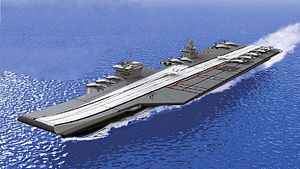The Indian Ministry of Defense (MoD) has still not approved plans to move forward with the acquisition of the Indian Navy’s first supercarrier, the future 65,000-ton flattop INS Vishal, the second ship of the Vikrant-class, according to Indian media reports. As of this month, the MoD has not issued a so-called Acceptance of Necessity note, the first official step in procuring a new defense platform.
The principal two reasons for the delay are difficulties with the carrier’s design and the Indian Navy’s declining budget. The proposed new supercarrier, to be constructed at the Cochin shipyard in southern India, is part of the Indian Navy’s Maritime Capability Perspective Plan (MCCP) which foresees the creation of three carrier strike groups with two groups deployed on the east and west coasts of India and the third held in reserve.
The future INS Vishal is expected to be capable of carrying up to 55 aircraft (35 fixed-wing combat aircraft and 20 rotary wing aircraft) launched using a catapult assisted take-off but arrested recovery (CATOBAR) aircraft launch system, which purportedly will include U.S. defense contractor’s General Atomics’ new electromagnetic aircraft launch system (EMALS) technology also found on the U.S. Navy’s new Gerald R. Ford-class carriers.
“The INS Vishal will be the first non-Western aircraft carrier equipped with the complex CATOBAR launch capability,” I explained previously. “CATOBAR aircraft launch systems put less strain on the airframe of planes during takeoff reducing maintenance cost in the long run and also allows carrier-based aircraft to carry a heavier weapons payload. Furthermore, CATOBAR launch systems increase the sortie rates of carrier air wings by allowing a faster landing and takeoff rate.”
The new carrier will be conventionally-powered. Initial plans for using nuclear propulsion were discarded following a report by the Bhabha Atomic Research Center, India’s premier nuclear research facility headquartered in Mumbai, that it would take 15 to 20 years to develop a nuclear reactor large enough for the 65,000-ton aircraft carrier.
The Indian Navy has officially issued a request for information for a new carrier-based multirole aircraft in January 2017 for service aboard the new supercarrier. As I noted in December 2016, the Indian Navy does not intent to deploy the naval variant of the Hindustan Aeronautics Limited Light Combat Aircraft Tejas aboard the flattop, although the service could consider a lighter upgraded version of the fighter plane, the Tejas Mark II.
The top three contenders for forming the core of the carrier’s future air group are Boeing’s F/A-18 Super Hornet, a naval version of the Dassault Rafale, and the Russian-made MiG-29K Fulcrum fighter jet. The Indian Navy’s preference for the CATOBAR aircraft launch system, however, makes it unlikely that the service will select the MiG-29K, given that other aircraft have greater endurance and can carry heavier weapons loads.
Total acquisition costs for the new carrier, expected to enter service in the 2030s, are estimated at between $11-15 billion.

































